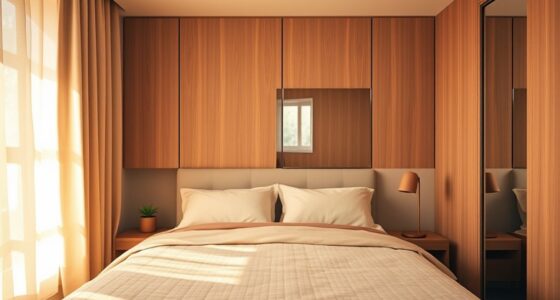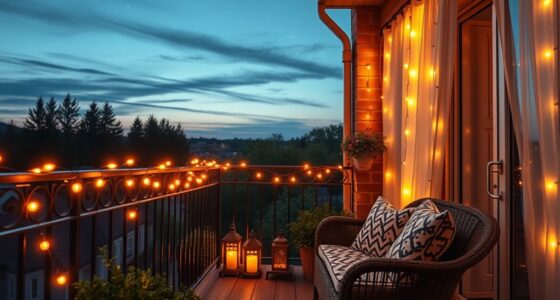To make a room feel bigger with mirrors and light, place mirrors opposite windows to bounce natural light and reflect a sense of space. Use well-placed, large mirrors to visually expand the room, and complement them with layered lighting like sconces or ambient lights to brighten the space evenly. Experiment with light colors and angles to enhance reflections and open up the room further. Keep exploring for more tips on how lighting and mirror placement can transform your space.
Key Takeaways
- Position mirrors opposite windows to reflect natural light and visually expand the space.
- Use well-placed, balanced lighting around mirrors to brighten the room and enhance their reflective effect.
- Choose large, rectangular mirrors to maximize reflected surface and create a sense of openness.
- Hang mirrors at eye level and angle them to reflect focal points, increasing perceived room size.
- Combine ambient and task lighting with mirrors to evenly distribute light and make the room feel more spacious.

Have you ever wondered how mirrors manipulate light to create reflections? It’s a fascinating process that can dramatically change the perception of a space. When you’re trying to make a room feel larger, understanding mirror placement is essential. Position your mirrors thoughtfully to maximize their effect. For example, placing a mirror directly opposite a window allows it to bounce natural light around the room, making the space feel more open and airy. Alternatively, angling a mirror to reflect a focal point, like a beautiful piece of artwork or a well-lit corner, draws the eye inward and creates the illusion of depth. The key is to avoid placing mirrors where they’ll reflect clutter or dark areas, as this can make the room feel cramped rather than expanded.
Lighting techniques go hand in hand with mirror placement to enhance the sense of spaciousness. Bright, well-distributed light reflects better and helps your mirrors do their job effectively. Use a combination of ambient and task lighting to guarantee the room is evenly lit. For instance, installing wall sconces on either side of a mirror can provide balanced illumination, reducing shadows and emphasizing the reflective surface. When you add lighting that highlights the mirror itself, it becomes a focal point that draws the eye inward, subtly expanding the room’s perceived size. Keep in mind that warm light creates a cozy atmosphere, but cooler light can make a space feel more open and invigorating. Experiment with different lighting temperatures to find what best enhances your room’s size and ambiance.
Another important aspect is the size and shape of your mirror. Large, rectangular mirrors tend to make a space look bigger because they reflect more of the room. If you’re limited on space, a tall, narrow mirror can create the illusion of height, making ceilings seem higher and the room more expansive. Strategic mirror placement also involves considering the angles and height at which you hang them. Positioning a mirror at eye level for most viewers ensures it reflects what you want to showcase, whether that’s a window, a piece of furniture, or a view outside. Additionally, understanding light reflection techniques can help you optimize how mirrors bounce light around your space. When combined with effective lighting techniques, your mirrors can turn a small, confined room into a bright, open oasis. Remember, the goal is to reflect light and space, so plan your mirror placement carefully and use lighting to complement your design. This simple approach can make a surprisingly big difference in how your room feels.
Frequently Asked Questions
Can Mirrors Be Used to Hide Imperfections on Walls?
Yes, mirrors can help hide imperfections on walls by reflecting light and creating a sense of depth. To do this effectively, you should carefully plan your mirror placement, positioning it to cover or distract from wall textures and flaws. Choose a mirror shape and size that complements your space, ensuring it’s large enough to divert attention from imperfections and make your room feel cleaner and more polished.
What Types of Lighting Work Best With Mirrors?
You should use natural light and ambient lighting with mirrors to create a bright, inviting space. Natural light reflects beautifully off the mirror’s surface, enhancing the room’s openness. Pair it with soft ambient lighting, like wall sconces or LED strips, to evenly illuminate the area without harsh shadows. This combination maximizes the mirror’s effect, making your room appear larger, more vibrant, and welcoming.
How Do Mirror Shapes Influence Room Size Perception?
Ever wonder how mirror shapes influence your perception of space? Opt for elongated or vertical mirrors to draw the eye upward, making ceilings seem higher and rooms feel larger. Rounded or irregular shapes soften the room’s edges, creating a sense of flow. By choosing specific mirror shapes, you enhance perception, opening up your space and making it feel more expansive. It’s all about strategic perception enhancement through thoughtful mirror design.
Can Mirrors Improve Room Acoustics Along With Lighting?
Yes, mirrors can improve room acoustics by acting as acoustic reflectors, bouncing sound waves and reducing echoes. They also enhance visual expansion, making your space feel larger and more open. When positioned correctly, mirrors not only amplify light but help create a balanced acoustic environment. This dual function boosts both your room’s ambiance and sound quality, giving you a more comfortable and inviting space to enjoy.
Are There Safety Concerns With Large or Wall-Mounted Mirrors?
Yes, large or wall-mounted mirrors can pose safety concerns if not properly installed. You should make sure they’re made of safety glass to prevent injuries if broken. Proper wall anchoring is essential to keep the mirror secure and prevent accidents. Regularly check the mounting hardware and wall attachments to avoid falls or damage. Taking these precautions helps you enjoy the aesthetic benefits while maintaining a safe environment.
Conclusion
By using mirrors and light, you can turn any small room into a spacious oasis. Think of mirrors as windows to a larger world, reflecting not just images but also your potential. When you flood your space with light, it feels like the walls breathe and expand. Together, these elements work like magic, transforming your room into an open canvas. So, go ahead—brighten and reflect your way to a room that feels bigger than life.









